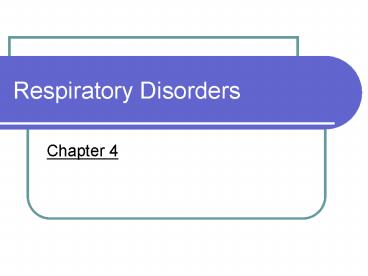Respiratory Disorders PowerPoint PPT Presentation
1 / 23
Title: Respiratory Disorders
1
Respiratory Disorders
- Chapter 4
2
Anatomy Physiology
- Pulmonary System
- Ventilation
- Oxygenation
- Respiratory Tracts
- Upper warm, filter humidify air
- Nose
- Sinus
- Pharynx
- Larynx
- Lower
- Exchange of O2 and CO2
- Trachea lungs
3
The Evaluation Process
- History
- Acute/chronic
- Type of cough
- Shortness of breath?
- Pain with breathing
- Time of day
- Exacerbation with activity
- Allergies
- Medication
4
The Evaluation Process
- Inspection
- Shape of thoracic cavity
- Posture
- Breathing patterns
- Tachypnea rapid (gt24/min)
- Hyperpnea - deep
- Bradypnea slow (lt12/min)
- Hypopnea shallow/slow
- Orthopnea shortness when supine/prone
5
Abnormal Breathing Patterns
6
The Evaluation Process
- Palpation/Percussion
- Symmetry of chest during respiration T9/T10
- Tactile fremitus bilateral
- Percussion of thoracic cavity
- Posterior chest
- Right lateral thorax
- Left lateral thorax
- Anterior chest
7
Landmark Identification - Percussion
- Posterior chest
- Superior angle
- Spine
- Mid medial border
- Inferior angle
- Ribs 9-10
- All bilateral
- R/L Lateral Thorax
- Ribs 2-3
- Ribs 4-5
- Ribs 6-7
- Ribs 7-8
- All bilateral
8
Landmark Identification - Percussion
- Anterior Chest
- Superior to sternoclavicular jt.
- Ribs 2-3 (1-2 lateral to sternum)
- Ribs 4-5 (inferior to nipple/pec)
- Ribs 6-7 (middle of intercostal space)
9
Breath Sounds
- Intensity
- Pitch
- Quality
- Duration
10
Tips for Auscultation
- Use the diaphragm
- Listen to one full respiration at each location
- Follow the same pattern
- Compare side to side
11
Normal Bronchial Breath Sounds
- Heard over the trachea and larynx
- High-pitched
- Loud
- Inspiration lt expiration
- Harsh, hollow, and tubular
12
Normal Bronchovesicular Breath Sounds
- Posterior
- Heard between scapula
- Anterior
- Heard around Angle of Louis
- Medium-pitch
- Moderate amplitude
- Inspirationexpiration
- Mixed quality
13
Normal Vesicular
- Heard over peripheral lung fields
- Low-pitched
- Soft amplitude
- Inspiration gt expiration
- Sounds like rustling of leaves on a tree
14
Discontinuous, Fine Crackles
- Produced by inhaled air colliding with previously
deflated airways. Airways suddenly pop open - High-pitched (Sibilant)
- Heard mostly on inspiration
- Not cleared by coughing
15
Discontinuous, Course Crackles
- Produced by inhaled air colliding with secretion
in trachea and large bronchi - Loud, low-pitched (Sonorous)
- Start in inspiration and may be present in
expiration - May decrease with coughing or suction
- Clinical examples Pulmonary edema, pneumonia,
pulmonary fibrosis
16
Continuous, Sibilant Wheeze
- Produced by air being squeezed through narrowed
air passages - High-pitched
- Musical quality
- Predominate in expiration, but may be heard in
inspiration too - Acute asthma
- Chronic emphysema
17
Continuous, Sonorous Wheeze
- Produced by airflow obstruction
- Low-pitched
- Snoring or moaning sounds
- More prominent on expiration
- May clear with coughing or suction
- Bronchitis
- Tumor in single bronchus
18
Stridor
- Caused by constriction of larynx, trachea, or
upper airway obstruction - High-pitched, crowing sound
- Heard on inspiration and louder in neck area
- Croup
- Foreign body
- Inhalation injury
19
Pathological Conditions
- Pneumonia
- Viral or bacterial pathogen
- S/S
- Dyspnea, wheeze, cough/bark, mucous
- Diagnosis
- Sputum culture
- Chest X-Ray
- Treatment
- Antibiotics, expectorant/cough suppressant
20
Pathological Conditions
- Influenza
- Viral infection
- S/S
- Contact with infected person
- Fever, body ache, cough, etc
- Precursor to pneumonia
- Diagnostics
- MD, blood tests,
- Treatments
- symptomatic
21
Pathological Conditions
- URI bacterial infection
- S/S
- fever, cough, body aches, runny nose, sore throat
- Diagnosis
- Symptoms persist for 7-10 days
- Dark nasal discharge
- Treatment
- Symptomatic, antibiotics, good hygiene
22
Pathological Conditions
- Spontaneous Pneumothorax/Hempthorax
- Air/gas trapped between chest wall and pleura
causing lung to collapse - Blood collects in pleural space due to direct
trauma - NOT TO BE CONFUSED WITH HAVING THE WIND KNOCKED
OUT
23
Spontaneous Pneumothorax/Hempthorax
- S/S
- Dyspnea, cough w/chest pain, history of chest
trauma - Diagnosis
- Immediate referral, X-Ray,
- Tx aspiration of trapped air, drainage of blood
- RTP Decision recurrence can be 50,
asymptomatic, clearance by MD

